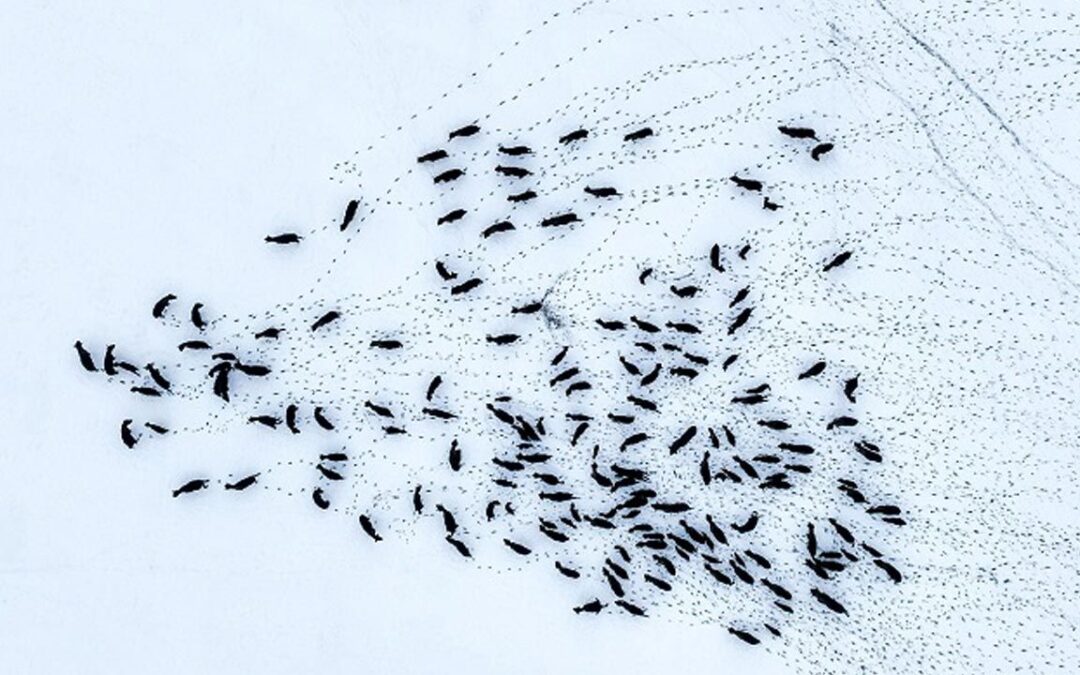An enormous herd of bison, containing up to 170 of the animals, has been spotted on the outskirts of Białowieża Forest in eastern Poland. Scientists say it is the largest they have ever seen.
The group was observed at the end of December via drone by researchers from the Institute of Mammal Biology of the Polish Academy of Sciences (IBS PAN) in Białowieża, who monitor bison and study their reproduction. They released the image of the herd shown above.
“We were surprised to see such a large number of bison in one place,” Rafał Kowalczyk, who leads bison research at IBS PAN, told broadcaster TVP.
“We monitor bison herds in several places in Poland and abroad, and so far the [previous] largest herd, with 136 individuals, was observed by us this winter on the outskirts of the Knyszyn forest [in Poland],” he added.
“When we saw a massive herd on the outskirts of the Białowieża Forest, we wondered if it would match the Knyszyn one,” continued Kowalczyk. The images captured by the drone dispelled any doubts.
The herd, which includes 40 calves, is thought to have formed from a combination of several smaller groups of bison observed in the area at the beginning of winter.
A domesticated cow escaped from her farm and spent the winter with a herd of wild bison in Poland's Białowieża Forest.
She 'chose freedom', says a local scientist https://t.co/KXu90vZC7S
— Notes from Poland 🇵🇱 (@notesfrompoland) January 24, 2018
Their coming together was likely caused by the sudden onset of winter, heavy snowfall, and a drop in temperature to well below 0°C. In such conditions, bison group together in larger herds to increase their chances of survival.
Information about the massive herd was not immediately released by the researchers so as to avoid drawing large numbers of photographers and other wildlife watchers.
Bison were hunted to extinction in the wild in Poland and elsewhere in Europe in the early 20th century, surviving only in captivity. However, programmes were launched in the 1950s to reintroduce them. Poland now has the continent’s largest population of the animal.
According to the International Union for Conservation of Nature (IUCN), the population of European bison has more than tripled in the last 20 years, from around 1,800 in 2003 to over 6,200 in 2019. There are 47 free-ranging herds in Europe, mainly in Poland, Belarus and Russia.
That led the IUCN in 2021 to upgrade the European bison from “vulnerable” to “near threatened” – which means it is no longer at risk of global extinction – on its Red List of Threatened Species.
“The number of bison in Białowieża Forest – and in Poland as a whole – is regularly increasing,” notes IBS PAN. “Last winter, the Białowieża National Park counted 779 bison in the forest. Part of the population migrates seasonally from the forest to open areas.”
Bisons’ growing numbers in Poland have also led to them again become a tempting target for some hunters. A report by Greenpeace in 2017 showed that hunters pay up to 12,000 zloty (€2,500) for organised bison hunts, which are able to take place legally if they are part of limited culls.
Main image credit: Instytut Biologii Ssaków Polskiej Akademii Nauk

Anna Hackett is an assistant editor at Notes from Poland. She is a recent graduate of European Studies from Trinity College Dublin and has had previous journalistic experience with the Irish Independent News & Media group.




















